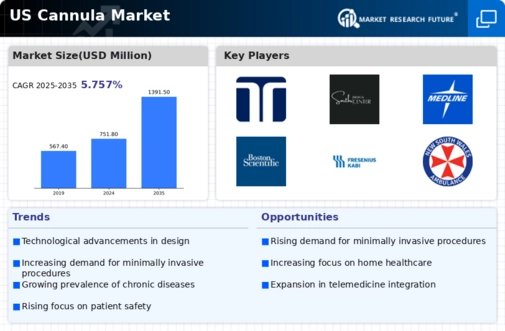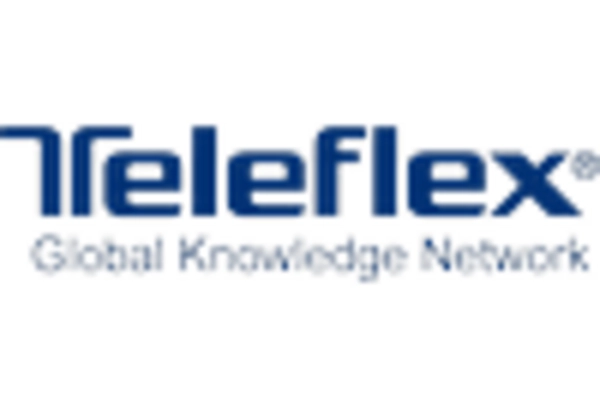Rising Geriatric Population
The increasing geriatric population in the United States is significantly impacting the cannula market. As individuals age, they often experience a higher prevalence of chronic conditions that require medical interventions, including surgeries and other procedures where cannulas are utilized. The U.S. Census Bureau projects that by 2030, approximately 20% of the population will be aged 65 and older, leading to a heightened demand for medical devices, including cannulas. This demographic shift is likely to drive growth in the cannula market, as healthcare providers seek effective solutions to cater to the needs of an aging population. Consequently, the market could see an increase in value, potentially reaching $1.6 billion by 2028.
Expansion of Healthcare Infrastructure
The ongoing expansion of healthcare infrastructure in the United States is a crucial driver for the cannula market. With the establishment of new hospitals, outpatient facilities, and surgical centers, there is an increasing need for medical devices, including cannulas. This expansion is particularly evident in underserved areas, where access to healthcare services is improving. As healthcare facilities enhance their capabilities, the demand for advanced medical devices is expected to rise. Market analysts suggest that this trend could lead to a market value increase, potentially reaching $1.7 billion by 2029. The growth of healthcare infrastructure is likely to create new opportunities for manufacturers and suppliers within the cannula market.
Focus on Patient Safety and Quality of Care
The emphasis on patient safety and quality of care is becoming increasingly prominent in the healthcare sector, significantly influencing the cannula market. Regulatory bodies and healthcare organizations are advocating for the adoption of devices that enhance patient safety, including those that minimize the risk of complications associated with cannula use. This focus is driving manufacturers to innovate and improve the design and functionality of cannulas. As a result, the market is expected to grow, with projections indicating a potential increase in value to $1.9 billion by 2030. The commitment to patient safety is likely to foster a competitive environment within the cannula market, encouraging continuous improvement and adherence to high standards.
Technological Innovations in Cannula Design
Technological advancements in the design and manufacturing of cannulas are playing a pivotal role in shaping the cannula market. Innovations such as the development of biocompatible materials and advanced manufacturing techniques are enhancing the performance and safety of cannulas. For instance, the introduction of smart cannulas equipped with sensors for real-time monitoring is gaining traction. These innovations not only improve patient outcomes but also increase the efficiency of medical procedures. The market is expected to witness a growth trajectory, with projections indicating a potential increase in market value to $1.8 billion by 2027. Such advancements are likely to attract investments and drive competition among key players in the cannula market.
Increasing Demand for Minimally Invasive Procedures
The cannula market is experiencing a notable surge in demand for minimally invasive procedures. This trend is largely driven by the growing preference among healthcare providers and patients for techniques that reduce recovery time and minimize surgical trauma. As a result, the market for cannulas, which are essential in such procedures, is projected to expand significantly. According to recent estimates, the market could reach approximately $1.5 billion by 2026, reflecting a compound annual growth rate (CAGR) of around 8%. This increasing demand is likely to encourage innovation and development within the cannula market, as manufacturers strive to meet the evolving needs of healthcare professionals and patients alike.

















Leave a Comment